“Everyone likes birds. What wild creature is more accessible to our eyes and ears, as close to us and everyone in the world, as universal as a bird?” David Attenborough.
If you’re lucky enough to have a garden or some outside space and are looking for something different to do with your children during the current lockdown, spending a bit of time feeding and watching the birds might be just the ticket.
Depending on where you live, attracting birds into your garden shouldn’t be too difficult, and seed, suet treats and nuts for birds is pretty easy to get hold of. And this time of year, when most birds are singing for mates, building nests, and raising young, is as good a time as any.
Garden bird watching in East Sussex
The really good news is that watching the birds in your garden will not only be an educational way to pass some time, but it will be good for your mental health too. A report published just a few months ago showed how switching off from our increasingly busy routines and immersing ourselves in nature for just a few minutes a day can significantly help with mental health.
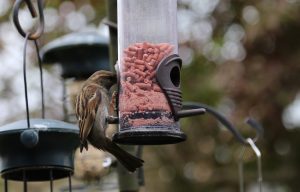
A sparrow feeding in my garden
I’ve had several bird feeders and bird boxes in my garden for many years, and have always had a keen fascination with our feathered friends. As I write this, working from home, my desk looks out on to a small patch of garden where I have a feeding station with two feeders on it. There’s a blue tit eagerly pecking at the suet treats, and a sparrow less delicately attacking a seeded fat ball. A bossy robin is perched on top of the feeders about to show the others who’s boss, and a juvenile blackbird is in the garden below, picking up the pieces of food the two above are dropping.
The RSPB recently published the results of its Big Garden Birdwatch which was carried out in January by hundreds of thousands of people up and down the country. See how many of these you can attract and spot in your garden: Big Garden Birdwatch Results
But if you spend time watching the birds I would suggest you don’t just do so to tick them off a list. What becomes fascinating is getting to know more about different species, their behaviours, their personalities (yes, they have different ones) the food they like, and how they interact with others.
Robin
For example, while the robin is a cute national favourite and makes regular appearances on Christmas cards, it actually is quite a feisty little bird which is not afraid of making its presence known – even to much bigger feathered friends. If another robin ventures on to its territory the fights can be pretty horrible. They’re also amongst the most inquisitive and less timid, and they seem to love dried mealworms.
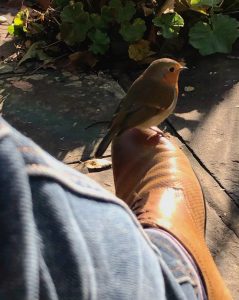
The curious robin that perched on my foot
Often when I’m in the garden a robin will come and perch near to where I’m working. Sitting in the park one lunchtime (before lockdown, of course) one even rested on my shoe and looked up at me. He, or she – it’s difficult to tell as they both have similar colourings – sat there for some minutes enjoying the sunshine and trying to sum me up.
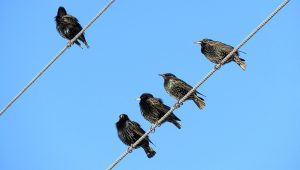
Starlings move in gangs
Starlings
Starlings are a bit thuggish. If you catch their feathers in the sunlight they are a mix of beautiful vibrant colours, but they move in intimidating groups and like to boss their way around the garden. They do use the feeders but they’re pretty clumsy on them and they lack the poise of some of their counterparts. They are the “come over here if you think you’re hard enough” visitors to my garden.
Blackbirds
Blackbirds, in contrast, are serene and majestic birds. Their deep, rich warbled song is extremely distinctive and you often see them in pairs – the male a dark black with bright orange beak, the female more dark brown in colour. One place you almost certainly won’t see them is hanging from the bird feeders. Unlike the rebellious starlings they tend to recognise their limitations and will generally be on the ground – preferring worms and bugs for food, although grateful for any debris falling from the feeders.
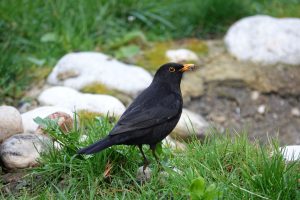
Blackbird – arguably the most beautiful song
You’ll be lucky to see finches – goldfinch or greenfinch but if you do, notice how their beaks are a bit different. They are more cone-shaped and are tougher – designed to crack open seeds. Birds like the dunnock – similar to a house sparrow but a bit smaller, slimmer and with a grey front – have thinner more pointed beaks for bugs and insects. The dunnock will also be on the floor, not on the feeders.
Blue tits
Blue tits are just beautiful birds. And they’re the ones that will set up residence in a clean bird box if you put one up in your garden and there’s an easy supply of food nearby. And if you get a blue tit nesting in your garden there’s so much to enjoy. Watch as the adult birds (mainly the female) first start building their nest – regular trips in and out of that tiny hole with any nesting material they can find.
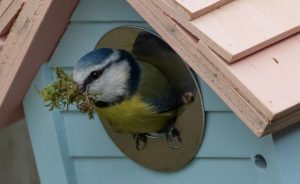
Blue tit nesting
Then you’ll see them less. This will be when eggs have been laid and the female will spend most of her time sitting on them to incubate them. There might be anything up to a dozen. You’ll still see the male – never far away from the nest protecting his potential family and bringing food for the female. After a couple of weeks the frantic activity will begin again as both adult birds pretty much full-time fly to and from the nest feeding the newly hatched babies inside. The baby birds need a lot of feeding and it is relentlessly tiring work for the adults. If you sit outside and watch the nest (from a suitable distance) you’ll hear the sounds of the young birds chirping eagerly and urgently as they call for food.
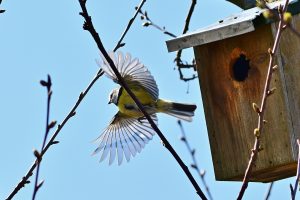
Blue tit flying the nest
After about three weeks you’ll see little faces appearing at the bird box entrance as the babies prepare to fledge. If you’re really lucky with timing, you’ll get to see it happen. One after another they will appear and, if they’ve exercised their new wings sufficiently, will make the first tentative flight (more a jump with flapping really) out of the box and on to a nearby branch. But that’s not where it ends – you’ll still see the family group hanging around together for some time and the adults will continue to feed as the newcomers learn how to. You’ll recognise the youngsters as they’ll still have some of their early fluffiness.
Other familiar friends
The other birds you’re likely to see are the plodding wood pigeons – so much more attractive than their feral relatives that populate our towns – collared doves, and, of course, the house sparrows. The latter will often be in family groups – the male with darker brown markings.
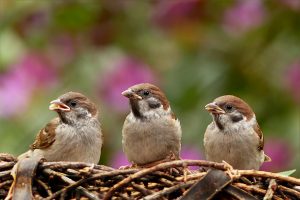
They may be common but the humble sparrow is still fascinating
Also more often than not in family groups, but less frequent to visit, will be the wonderfully delicate long-tailed tits. As their unimaginative name suggests, they stand out because of…their long tails.
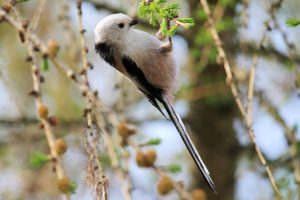
The long-tailed tit
Bigger than the blue tit, keep an eye open for great tits too. They have distinctive black heads and a dark stripe down their chests. You’ll know their song – it sounds like someone pushing a wheelbarrow with a wheel that needs oiling.
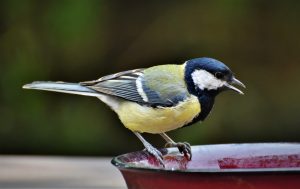
The Great tit has a distinctive song
Wrens are often in my garden and they have a high pitched fast song. You’ll recognise them easily because they’re small and have a distinctive up-turned pert tail. I also used to get chaffinches regularly – the male is an orangey brown colour with a blueish head. It has a repetitive song which always ends with a sound that I think is like someone saying “Big Issue”. They are less frequent these days, however.
Other birds to look out for are the larger black and white magpie, and less frequent these days, the thrush. If you see a thrush – blackbird size but brown with a speckled chest – it’s most likely going to be a song thrush. Its mistle thrush relative is more rare. If you have large trees you might see a grey-backed, orange-bellied nuthatch climbing up the trunk with its Dick Turpin like black eye mask. If you’re really lucky you might even see a black and white woodpecker with its flashes of red feathers.
Crows and rooks
Crows and rooks are quite tough to tell apart but if the bird is alone it’s more likely to be a crow. Rooks are more often in groups. Slightly smaller than the crows and rooks but still bigger than the blackbird, you might see a jackdaw. It will have a silver grey neck and a scarily piercing eye.
Obviously all of this is only possible if you have some outside space. If, however, you don’t, you could always try one of those feeders that suckers on to windows. I have one this year for the first time and was extremely sceptical that it would be used. But sure enough the sparrows, tits and even the heavy-handed clumsy starlings regularly do so. And, unsurprisingly, the robin not only feeds from it, but also perches on top of it, looking in the window to spot me.
Patience will be rewarded
The point is there are some birds you are much more likely to see but you never know what will turn up. A friend of mine recently sent me a picture of a large bird that had arrived in her garden asking what it was. It was a sparrowhawk – a magnificent and beautiful bird of prey.
Put bird food out, sit indoors at a window as still as you can, and if you can get a pair of binoculars, even better. Then all you have to do is relax and wait. Birds know where there’s food to be had so it might take a few attempts before you start seeing visitors arrive. But in all the places I have lived I’ve always managed to attract some feathered friends. They are amazing to watch, and can be a wonderful way of pausing, reflecting, and distracting ourselves from the fast-paced world we often find ourselves in.
The RSPB has a very good guide that, if you’re new to birdwatching, will help you identify them. You can find it here: RSPB bird identifying and the team at BBC Wildlife Magazine have the following tips for watching birds in your garden: Watching garden birds
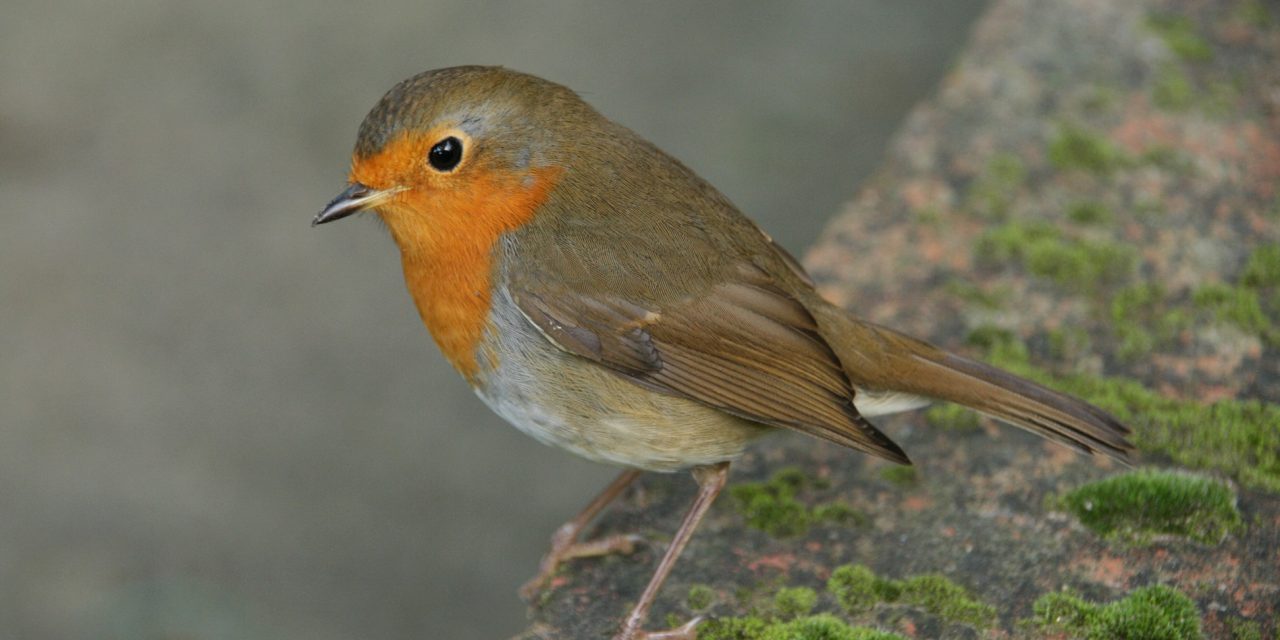
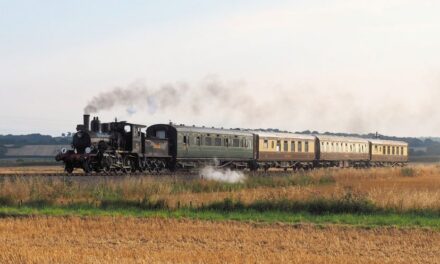



Very readable article Iain but why was I only able to rate it 3.5 and not more as I would have wished?